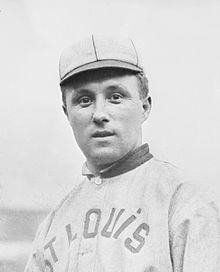| Paul Krichell | |
|---|---|
 Paul Krichell during the 1911 season | |
| Catcher | |
| Born: December 19, 1882 Paris, France | |
| Died: June 4, 1957 (aged 74) New York City, U.S. | |
Batted: Right Threw: Right | |
| MLB debut | |
| May 12, 1911, for the St. Louis Browns | |
| Last MLB appearance | |
| September 22, 1912, for the St. Louis Browns | |
| MLB statistics | |
| Batting average | .222 |
| Home runs | 0 |
| RBIs | 16 |
| Teams | |
| Career highlights and awards | |
| |
Paul Bernard Krichell (December 19, 1882 – June 4, 1957) was a French Major League Baseball catcher, best known for being the head scout for the New York Yankees for 37 years until his death. Krichell's talent evaluations and signings played a key role in building up the Yankees' run of success from the Murderers' Row teams of the 1920s to the 1950s teams led by Casey Stengel.[2]
Krichell began his professional career in the minor leagues, playing as the reserve catcher for the St. Louis Browns before a serious injury threatened his career. He continued to play in the minor leagues and began to move into coaching before Yankees manager Ed Barrow signed him as a scout in 1920. Considered one of the greatest scouts in baseball history, Krichell signed over 200 players who later played professional baseball,[3] including future Baseball Hall of Famers Lou Gehrig, Hank Greenberg, Phil Rizzuto, Whitey Ford, and Tony Lazzeri. His recommendation of Stengel as the Yankees manager was instrumental in Stengel's appointment in 1948. Barrow called Krichell "the best judge of baseball players he ever saw".[4]
- ^ "Paul. B. Krichell of Yankees dies". The New York Times. June 5, 1957. Retrieved February 4, 2010. (subscription required)
- ^ James (1995), p. 217
- ^ Caremer, Dave (July 1957). "36 Years as a Yankee". Baseball Digest. pp. 27–39. Retrieved February 4, 2009.
- ^ Gallagher, p. 343